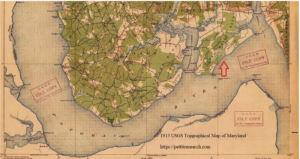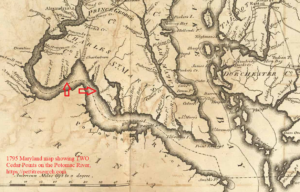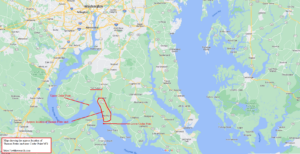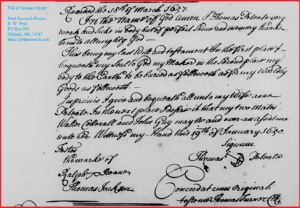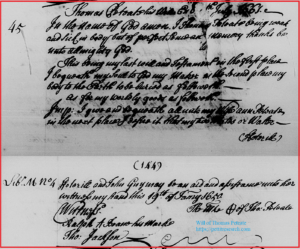First Pettits in America Series #8 -Thomas Pettit/Petite Maryland 1639
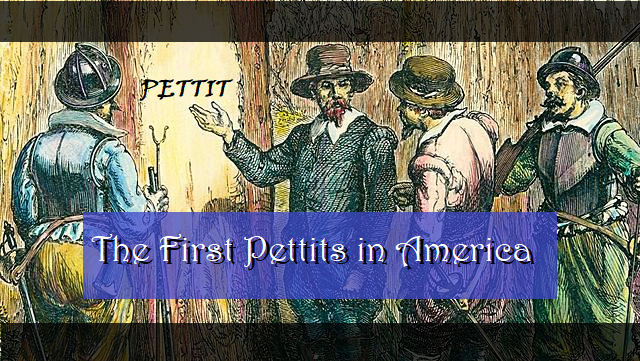
Thomas Pettit/Peteet/Petite/Peteate of Maryland
Thomas Pettit was a very early immigrant to Maryland arriving in the province in 1639. His surname is found in Maryland records with spelling variations from “Peteate” to “Petite” and everything in between. “Petit” seemed to be the preferred pronunciation. The majority of records spell his name “Petite”, therefore, we will refer to him as Thomas “Petite” for the sake of consistency.
The number of available records covering this man’s life is staggering, especially when one considers the early time period in which he lived. In an attempt to produce a comprehensive life story this article will reference almost all available sources -omitting only those that are redundant. Consequently this will be quite lengthy. It may prove useful to those doing intense research on him or related families but if you are here for just a casual review of this man’s life , you should consider skipping down to the summary at the end.
1639 Arrival in Maryland
A Thomas Petite arrived in the Maryland colony in 1639. At the time, Maryland imported both Catholics and Protestants and was surprisingly tolerant to religious pilgrims of all sorts. Thomas’ country of origin was not declared but he kept company with English speaking people. In the early 1600s Maryland had a headright system in place which required a declaration before the court before a warrant for land would be issued. This system is fully described by the Maryland State Archives with the pertinent part quoted below:
During the first years of his Province of Maryland, 1633-1681, Lord Baltimore rewarded people who transported themselves or others with rights to land, usually called headrights. For most of the period, the reward was a right to 50 acres of land per person transported. To enter and exercise his rights, a person had to give the names of those, including himself, whom he had transported. Therefore, the records of these transactions include the names of the settlers.
The Maryland State Archives has numerous land records and these are bountiful sources of genealogical information. It is from these early documents we learn when and how Thomas Petite arrived in the new world. Most of the following records can be found in the collection of the Maryland Land Office in the MD State Archives. This one is from Liber A, Folio 178 and states:
Septembr 19th, [1646] Nicolas Cawsin demandeth 1000 acres of Land for transporting himselfe & 2 men Servants Viz Julian Bernett, & John Taylor into this province & for transporting at his owne cost & charge 2 other persons, Viz Arthur La Hay, & Tho: [Thomas] Peteet, all in the year 1639, & one hundd acres more for bringing into this province one able man-servant, Viz John Walter, in the year 1642.
This record revealed that a Thomas Petite was transported to the colony as a free person along with Nicolas Cawsin and Arthur La Hay in 1639. Petite’s trip was paid by Cawsin who received a 1000 acre headright for transporting at least the five named people into the colony including himself and maybe others. On August 30, 1649, a warrant for a survey of 1000 acres for Nicolas Cawsin was issued. The location of the land was on the Potomac River “between Ceder Point and the head of Portobacko [Port of Tobacco] Creek.” (Ibid, Liber A, Folio 275)
Note the mention of Ceder Point on the Potomac River. This clue will be important later…
Moving on, we further discover that Thomas Petite paid to have his wife brought to the colony, also in 1639, and Catherine Petite, a child presumed to be his daughter, in the year 1645. He received a headright grant for each. His petition for the land due him is found in the same record collection in Liber A, Folio 233 which gives the following useful information:
[January 24, 1646] This day came Tho: Petite & demanded 100 acres of land dew by the assignmt of John Gray & 100 acres more by assignmt from Nicolas Cawsin & 100 acres for transporting his wife into the province in the year 1639 & 50 acres for bringing into this province once child Viz Catherine Petite in the yeare 1645.
Also on this page we find a petition of a man named John Gray [sometimes spelled Guy/Gay] who assigned his right to land to Thomas Petite:
January 24th. John Gray demandeth 100 acres of Land for transporting himselfe into this province in the year 1640. This day John Gray passed all his right & tytle in the foresaid land unto Thomas Petite.
It was around this time in the late 1640’s that Thomas began his efforts acquire title for land in his own name.
Settling Down and Obtaining Land
As noted above, Thomas Petite obtained 100 acres for transporting his wife to the colony and 50 acres for the child Catherine Petite. He petitioned for this land in 1646. That same year he gained ownership of the 100 acre headright due John Gray bringing his total acreage to 250. From 1646-1649 he obtained an additional 100 acres from Nicolas Cowsin and 100 acres from Walter Cotterell increasing his plantation’s size up to 450 acres. These transactions are found in Liber A, Folio 245-246 which states:
24 January 1648.
I do hereby assign all my right and title in 100 acre of land due me uppon record unto Thomas Petite witness my hand the day and year above written. Nicolas Cossin
Anno dni 1649
Thomas Petite demandeth 100 acres due him by assigment from Walter Cottrell 9th die April.
This day Walker Cottrell came and demanded 100 acres of land for transporting himself into this province in Anno dni 1640. And the same day he assigned over his right & title to the said 100 acres to Thomas Petite. Signed Walter Cotterell
The same day a warrant issued to surveyor to lay out 450 acres for Thomas Petite on Patomeck River neere Ceder point return by Michael next.
On October 1, 1649 we run into an interesting record that somewhat contradicts the previous account of Thomas Petite’s immigration costs. On Liber A, Folio 280 we read:
1 Oct 1649 Thomas Petite assigned over to William Marshall his right and interest in 200 acres of land due to him for transporting himself and his wife into this province about four years since witness his hand this first of October 1649
This particular record indicates that Thomas Petite paid for the importation of both him and his wife and was due a grant for each. Previously Nicolas Cowsin had claimed the headright for importing Thomas Petite and it was implied that Petite only covered his wife’s costs. By this time, some 10 years later, Thomas Petite had acquired several acres of land and it is possible this fine detail was not that important. It may have been a minor error that passed by unnoticed. The purpose of the 1648-9 court appearance was to convey to William Marshall 200 acres which legally belonged to Thomas Petite and not necessarily explain the chain of title. That purpose was fulfilled by the next record on the next page which stated:
1 Oct William Marshall demandeth 100 acres of land for transporting one Richard Morris his manservant into this province before Christmas last 1648 and 200 acres due to him by Assignment from Thomas Petite and 100 acres from Walter Cotterell.
Thus, 200 acres owned by Thomas Petite were transferred to William Marshall while at least 250 acres remained in Petite’s hands.
Thomas Petite’s Land Near Cedar Point and the Potomac River
By October of 1649, the Petites had firmly established themselves on a creek near a place called Cedar Point on the north side of the Potomac River. For a time the creek in the vicinity of their home was even referred to as Petites Creek. It is first mentioned in the description of land laid out for George Manners in Liber A, Folio 290 which states:
Oct 25, 1649 Laid out for George Manners planter a parcel of land lying on the north side of Potomac River, on the east with Petites Creeke, on the north with a branch called Manners Branch, on the west with a line drawn southwest from a path at the head of Manners Branch in the Potomac River containing and now laid out for five hundred acres more or less.
This is also mentioned on October 25, 1649 in Liber A, Folio 293, which is the record of a warrant issued for Richard Bennett:
Oct 25 1649. Laid out for Richard Bennett a parcell of land lying in Patowmeck River on the north side of a Creek northward from Mr. Neales land now called Petites Creek… Containing and now laid out for three hundred and fifty acres.
The land was situated near a place called Cedar Point. Liber A Folio 293 describes the survey for Thomas Petite and references the Cedar Point location:
Sept 25 1649 Laid for Thomas Petite planter a parcel of land lying on the north side of the Patowmeck River near Cedar Point… Containing and now laid out for four hundred and fifty acres.
Where was Cedar Point? A place named Cedar Point is prominently marked on a 1913 USGS topographical map which can be seen below:
This, however, only has a 1 in 3 chance of being the same Cedar Point referenced in the land records from the 1600s. A 1795 map of Maryland shows there were two Cedar Points in existence in Maryland at the same time on opposite sides of the mouth of the Port of Tobacco River on the north side of the Potomac. Today they are known as “Upper Cedar Point: and “Lower Cedar Point” -“lower” being the one further down the river.
The Potomac is our area of interest but a third Cedar Point in Maryland is also shown on the 1799 John Anderson Map in the Chesapeake Bay. These three Cedar Points can be seen on a modern Google map by clicking here: Cedar Point, Upper Cedar Point, Lower Cedar Point.
Most of the land transactions and geographic place names above were neatly summarized by the land grant found in Liber A, Folio 294 which states:
A Grant of land to Thomas Petite.
Know ye that we for an in consideration that Thomas Petite hath 100 acres due to him by assignment from John Guy and 100 acres by assignment from Nicholas Cowsin and 100 acres by assignment from Walter Cotterel and 100 acres of land more due to him from transporting his wife into the province in the year 1639 and fifty acres more for bringing into this province one child named Katherine Petite in the 1645 there to inhabit and dwell… by these presents for us and our heirs doe give grant and endorsse unto the said Thomas Petite his heirs and assignes all that parcel of land lying on the north side of the Patowmeck River near Cedar Point… containing and now laid out for four hundred and fifty acres. Given at St. Maries under our great seal of our said Province of Maryland the 22nd day of November in the year of our Lord 1640.
Placing His Land on a Modern Map
Using this information and other records, we can determine which Cedar Point was the one near the Petite plantation and find the rough location of the Thomas Petite’s land. This can be done easily in the following way:
- In St. Mary Co land was laid out for Richard Bennett which mentions the Petite Creek. It was said to have been on the Potomac River, on the North side of Petites Creek northward from Mr. Neale’s land.
- Mr Neale’s land was bordered by land laid out for William Hungerford in 1649. Land at the back of Mr. Neals had a creek called Hungerford Branch.
- Hungerford Branch is mentioned in land laid out for Ralph Smith in 1680. It is said to be land formerly surveyed for Edward Bowles at a marked oak on Hungerford branch near the Pykawaxon.
- The Pykawaxon corresponds to modern day Piccawaxen Creek which is near Lower Cedar Point.
- Thus the Petite land was somewhere near the Lower Cedar Point.
For the purpose of this article we can narrow the location down to the general area seen in the map below:
It should be noted that there are ample records in the Maryland State Archives which would likely allow an interested party to ascertain the precise location of the land. At present, that effort has not been undertaken by this researcher.
Life on Petite’s Creek in the Province of Maryland
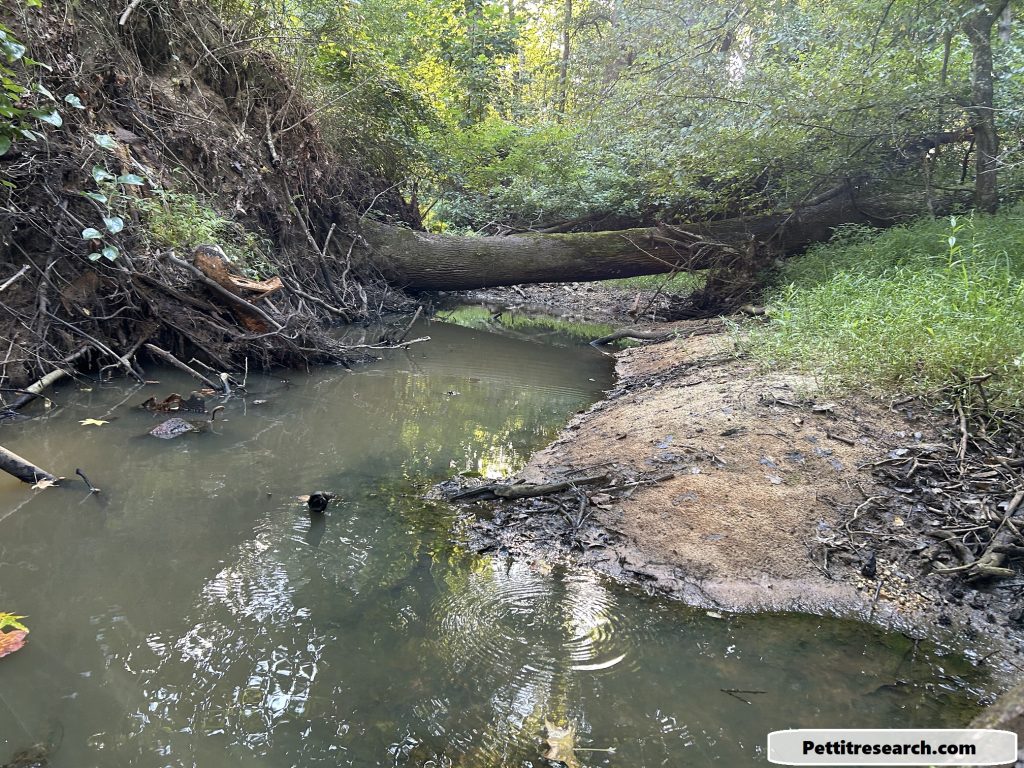
View of Mill Run near its junction with Piccowaxen Creek. This was likely on or very near Thomas Petite’s land. Photo taken by BW Pettit in August 2024.
“The Maryland Records of the Judicial and Testamentary Business of the Provincial Court” contains several entries which mention Thomas Petite. Some of these are duplicates of those already covered but a few are not. Most of these are quoted below. In quoting them, the English has been modernized for ease of readability but the spelling of names and places have been retained in their original form.
Liber P. R. Folio, 173:
1644 [October 13] Cutbert Fennick gent demandeth of Thomas Petit & John Guy 1892lbs tobacco with cask due by bill & 50 lbs tobacco with cask due upon book. attachment with citation vt supr.
Liber B, Folio 223:
[1649-1650] George Rutland demandeth of Thomas Petit 170lbs tobacco due by account assigned from Richard Hobie. Warrant to Court 1June
Liber AGB Folio 30:
Thomas Mathews. 10-25-1649, near a creek formerly called Port Tobacco but now Thomas Creek 10-126-1649. Ralph Crouch 10-26-1649. Lt William Lewis, near Port Tobacco Creek. Humphrey Howell, appointed by Thomas Petite and Thomas Mitchell, Surveyor.
Liber AGB Folio 236:
At a court held at St Johns 10 Feb [1648-9] Present Governor. John Neuell at the request of Francis Van Enden sayeth upon his oath, That before Christmas last at Thomas Peteet’s house Mr. John Hallowes bargained with Francis Van Eden & covenanted that the said Francis should make over all his right in his levy this year unto the said Hallowes, in consideration of a debt which the said Hallowes claimed of him. Whereupon the said Hallowes engaged himself that after he should receive the said levy to trust the said Francis with 1000lbs tobacco in goods. The said Francis giving bill for the payment thereof again the next year & further he sayth not. John + Neuell. Jurat in caria.
Liber A, Folio 207:
[1648] November 23 William Thompson demandeth of Thomas Petite 600lbs tobacco & cask due by bill. Warrant to the sheriff return December court next.Thomas Pasmore power Attorney Richard Browne demandeth of Thomas Petite 700lbs tobacco & cask due him for building and hire. Warrant to the sheriff return January court next.
The above record suggests Thomas Petite had hired Richard Browne to help him with some sort of building project. It is unclear what he had built. He already had house that was mentioned in a previous entry.
The record below tells us Thomas Petite raised cattle and hogs and memorialized his “brand”.
Liber A, Folio 281:
[1649] 29 Sept Thomas Petite his mark for cattle and hogs vis: crop on the right ear and slit and a little underkeeled on the left
Liber A, Folio 301:
[1649] Petite Thomas con John Hansford Case for 500lbs tobacco in cask attachment inde r eod [sic] since renewed.
The Iron Pot of Tar Controversy
In the year 1647 Thomas Petite found himself in court as material witness regarding a controversy over an iron pot of tar. Obviously, in those days resources would have been scarce and common household items would have had much greater value for the colonists than they would to us today. It seems a man named Walter Smyth had owned an iron pot and used it for storing and/or producing tar. This was likely some kind of tree based tar and would have had a variety of uses including sealing the wood in casks as well as waterproofing ships. In November of 1647, Smyth accused Edward Hall and Edward Packer of “wrongfully detaining a pot of iron.”
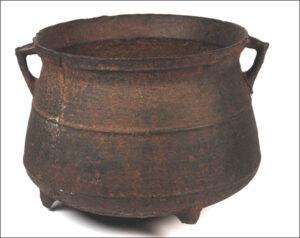
Colonial Iron Pot (Photo courtesy of Pilgrim Hall Museum Plymouth, MA)
Liber A, Folio 97:
[1647 November 12] Walter Smyth demandeth of Edward Hall administrator of Isaac Edwards an iron pot wrongfully detained, to the damage of two hundred pounds of tobacco. Warrant to the sheriff to arrest. return. primo die demb. Subpoena Thomas Petite to testify in eodem causa.Walter Smyth demandeth of Edward Packer one hundred and fifty pounds of tobacco for corn by contract, and wrongfully detaining a pot of iron. Damage 400lbs tobacco. Warrant to the sheriff to arrest. Returned p’mo die December.
Mr. Packer denied the charges in court. He proved to the court’s satisfaction that he did not detain the pot of iron, at least without already properly paying Mr. Smyth.
Liber A, Folio 102:
[1647 December 1] Upon the demand of Walter Smyth plaintiff against Edward Packer defendant for 150lbs tobacco & an iron pot. The defendant proved that he paid unto Barnaby Jackson, by the appointment of the plaintiff 100lbs and 50lbs more paid & confessed by the plaintiff. And further upon the oath of the defendant the court was satisfied that the defendant hath already paid the plaintiff for the pot. The court ordered that the defendant should be dismissed without pay, & the plaintiff to pay charges of court.
Though the case appeared to be closed, Walter Smyth had originally requested that Thomas Petite be deposed in the case. Petite appeared before the court on December 2, 1647, to declare what he witnessed regarding this very important issue.
Liber A, Folio 102:
[1647 December 2] Thomas Petite deposed at the request of Walter Smith sayeth that about Michaelmas was twelevemoth he being at Goddy Langsford’s plantation, the said Goody Langford told this deponent that in the plantation there was a pot of tarr, & if he needed he might make use thereof. But this deponent affirmeth that he never saw either pot of tar in the said plantation & further he sayth not. or to whome the pot belongeth, he knoweth not.
Apparently his testimony was too little too late for Mr. Smyth’s case. The court had already made a ruling and it is unlikely Petite’s inconsequential testimony would have persuaded them one way or the other anyway. There is no further mention of Mr. Smyth’s pot of tar in the court records. Smyth’s charges were dismissed and he was forced to pay the court costs associated with his suit.
Will of Thomas “Peteate”
Just a few years after the pot of tar incident, Thomas Pettit made out his last will and testament. The will of Thomas Petite was recorded in St. Mary County, MD on January 19, 1650. He left his entire estate to his wife. It is here at the end of his life that we finally find a record of his wife’s name Anne Peteate. There was no mention of Catherine Petite, the child he imported into the colony, nor any other children. He entrusted his friends Walter Cotterall and John Guy to assist his wife after his death. Guy and Petite appear together in other records mentioned above. It is likely they were friends, neighbors and fellow planters.
Sometime in 1650, Thomas Petite died. His widow Anne, then married his friend John Guy and they lived on the Petite plantation for about eleven years. The will of Thomas Petite was not executed until July 9, 1661, which may have been done by Anne Petite shortly after the death of John Guy. When John Guy passed away Anne married Peter Carr who managed the plantation with her for about 10 or 11 years. After about 10-11 years of marriage to Peter Carr, Anne died. All told she survived her husband Thomas Petite on the plantation he left for her for over 20 years.
Sometime after the demise of Anne Petite a jury was instructed to investigate the lands formerly belonging to Thomas Petite and determine if there was any living heirs. This record is the source for some of the valuable genealogy information mentioned in the paragraph above. The record is transcribed below:
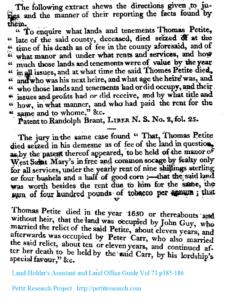
Kilty’s Land-Holder’s Assistant, and Land-Office Guide Vol73–186 Thomas Petite, Maryland State Archives (CLICK TO ENLARGE)
The following extract shews the directions given to
juries and the manner of their reporting the facts found by
them.” To enquire what lands and tenements Thomas Petite,
” late of the said county, deceased, died seized of at the
” time of his death as of fee in the county aforesaid, and of
” what manor and under what rents and services, and how
” much those lands and tenements were of value by the year
” in all issues, and at what time the said Thomas Petite died,
” and who was his next heire, and what age the heire was, and
” who those lands and tenements had or did occupy, and their
” issues and profits had or did receive, and by what title and
” how, in what manner, and who had paid the rent for the
” same and to whome,” &c.Patent to Randolph Brant, LIBER N. S. No.2, fol. 25.
The jury in the same case found ” That, Thomas Petite
died seized in his demesne as of fee of the land in question,
as by the patent thereof appeared, to be held of the manor of
West Saint Mary’s in free and common socage by fealty only
for all services, under the yearly rent of nine shillings sterling
or four bushels and a half of good corn;¾that the said land
was worth besides the rent due to him for the same, the
sum of four hundred pounds of tobacco per annum; thatThomas Petite died in the year 1650 or thereabouts and
without heir, that the land was occupied by John Guy, who
married the relict of the said Petite, about eleven years, and
afterwards was occupied by Peter Carr, who also married
the said relict, about ten or eleven years, and continued
after her death to be held by the said Carr, by his lordship’s
special favour,” &c.
The will of Thomas “Peteate” is recorded twice. This second recording may have had something to do with the examination and verification of the original will by the clerk. The two wills are practically identical. Copies of both can be seen below along with a transcription.
Transcribed Will of Thomas Peteate:
Recorded the 8th of March 1657
In the name of God amen I Thomas Peteate very weak and sick in body but of perfect *** and memory thanks be unto almighty God-
This being my last will and testament in the first place I give and bequeath my soul to God my Maker in the second place my body to the Earth to be buried as followeth
as for my worldly goods as followeth-
Imprimis I give and bequeath all unto my wife Anne Peteate In the next place I *** it that my two mates Walter Cotterall and John Guy may be as aid and assistance unto her Witness my hand this 19th of January 1650
Testos
The marks of
Ralph “R” Beane
Thomas Jackson
Signature Thomas “mark” Peteate
Recorded at cum orginali [“with the original”]
to follow Thomas Turner Clerk
Summary
Thomas Petite and his wife came to the Province of Maryland in the year 1639. In 1645 Thomas imported a child named Catherine Petite who is presumed to be his daughter though the record never explicitly declares this. By 1649 he had acquired the right and title to 450 acres of land near the lower Cedar Point on the north side of the Potomac River in western St. Mary County. His plantation was near what was once called Petite’s Creek. It was here he raised cattle and hogs and also grew tobacco as a “planter”. He made out his will on January 19, 1650, leaving everything to his wife Anne Petite. After his death, she married John Guy and later Peter Carr. She probably died some time after 1670. There is no indication of what happened to his daughter Catherine Pettit. She is not mentioned in his will and some twenty-plus years later the court found Petite had no legal heirs. It is therefore assumed Catherine was deceased by 1650. From the lack of heirs we can also infer that Thomas Petite had no male children to carry on his name.
As the family of Thomas Petite faded into the pages of Maryland history another Petite family entered the Maryland stage. In the next article we will look at the life of Francis “Poteet”, a Baltimore resident in the 1670s.
